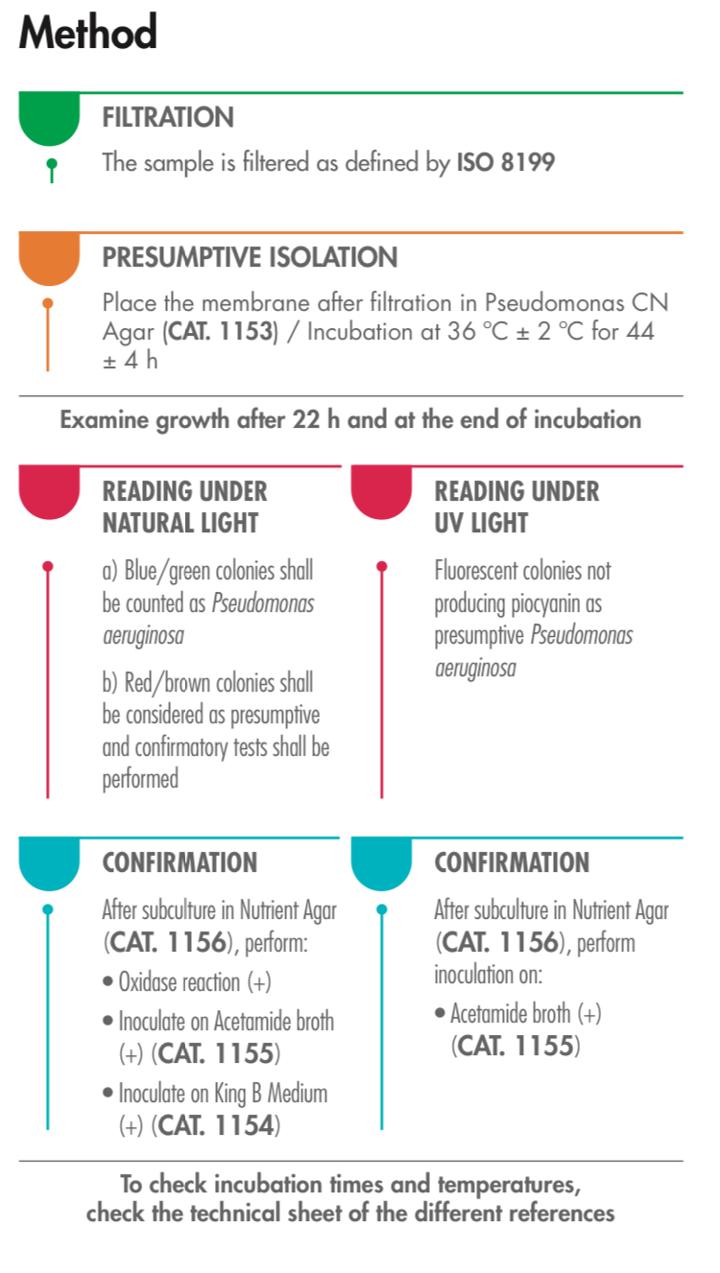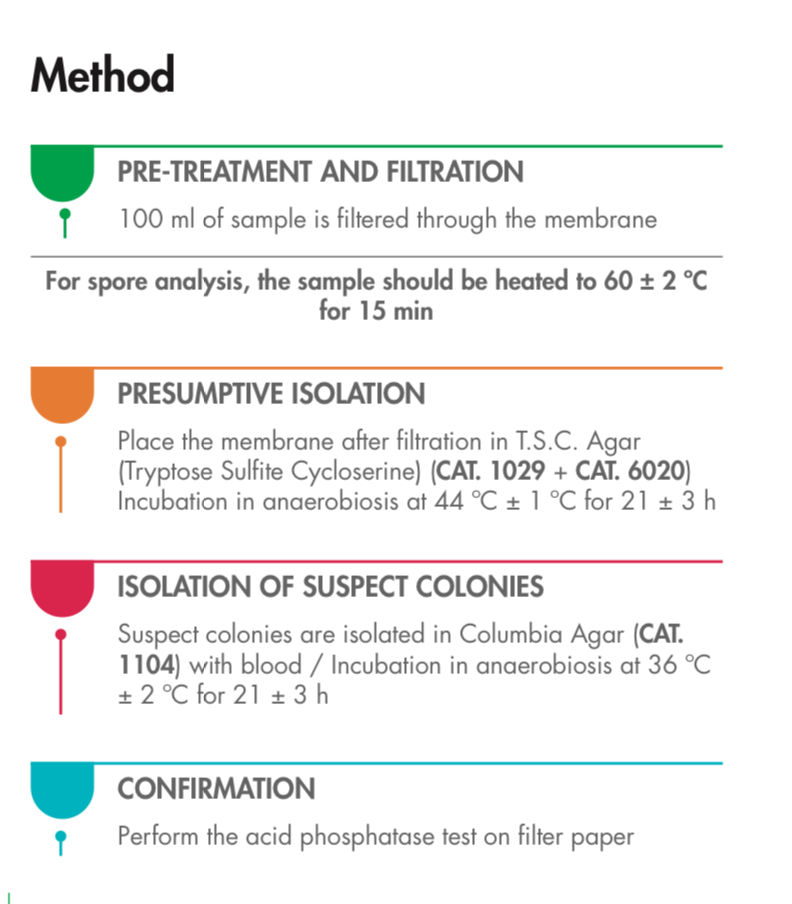Ensuring the safety and quality of our water supply is of paramount importance. In this blog post, we delve into the vital procedures for detecting and counting Pseudomonas aeruginosa and intestinal enterococci, as defined by ISO standards. Understanding these methods is crucial for safeguarding public health and the environment.

Filtration: The First Line of Defense
The process begins with filtration, a foundational step in the methodology. ISO 8199 defines the precise filtration parameters, ensuring that the sample is processed efficiently. This step is essential for capturing and concentrating microorganisms in the water sample.
Presumptive Isolation: Identifying Potential Threats
Once the filtration is complete, the next stage is presumptive isolation. Here, the filtered membrane is placed in Pseudomonas CN Agar (CAT. 1153) and incubated at a carefully controlled temperature of 36°C ± 2°C for a specific duration of 44 ± 4 hours. During incubation, it's essential to monitor the growth of colonies, both at the 22-hour mark and at the end of the incubation period.
Confirmation: A Rigorous Assessment
Confirmation is the next critical step in this method. After subculture in Nutrient Agar (CAT. 1156), several tests are performed to confirm the presence of Pseudomonas aeruginosa. These include:
- Oxidase reaction
- Inoculation on Acetamide broth (+) (CAT. 1155)
- Inoculation on King B Medium (+) (CAT. 1154)
These confirmatory steps are vital to ensure that the isolated colonies are indeed Pseudomonas aeruginosa and not false positives.
Reading Under Different Lights: Precision is Key
To further enhance the accuracy of detection, reading the colonies under different lighting conditions is crucial. In natural light, blue/green colonies are counted as Pseudomonas aeruginosa. However, red/brown colonies are considered presumptive, and further confirmatory tests are necessary.
When it comes to reading under UV light, fluorescent colonies that do not produce pyocyanin are considered presumptive Pseudomonas aeruginosa. This added layer of scrutiny ensures that the assessment is thorough and reliable.
METHOD FILTRATION is a comprehensive approach to detecting and confirming the presence of Pseudomonas aeruginosa in water samples. By following ISO 8199 and the associated steps, we can confidently assess water quality and take the necessary actions to maintain the purity and safety of our water supply.
Detecting Pseudomonas aeruginosa and Intestinal Enterococci
Water, the elixir of life, is a fundamental resource that we rely on daily. However, its purity and safety cannot be taken for granted. In this blog post, we will journey into the intricate world of water quality and the procedures that safeguard it, focusing on the detection and counting of two crucial microbial indicators: Pseudomonas aeruginosa and intestinal enterococci.
Why Water Quality Matters
The safety and quality of our water supply are paramount. Contaminated water can pose serious threats to public health and the environment. ISO standards provide a framework to ensure that water remains safe to drink and use. These standards are the bedrock of our discussion.
The confirmation stage involves various tests, including the oxidase reaction and inoculation on different media. These steps ensure the reliability of the detection results. To distinguish between Pseudomonas aeruginosa and other colonies, we explore the significance of reading under natural and UV light, where colony colors and fluorescence play a crucial role. Intestinal enterococci are reliable indicators of water quality and contamination. The ISO 7899-2:2000 method provides us with the tools to detect and count these microorganisms. As with the detection of Pseudomonas aeruginosa, the ISO 8199-defined filtration process is an essential initial step for isolating intestinal enterococci. Placing the filtered membrane in Slanetz-Bartley Medium and ensuring precise incubation conditions are crucial for the initial isolation of intestinal enterococci. To guarantee the accuracy of results, we detail the process of confirming and enumerating colonies, providing valuable insights into water quality assessment.
Why This Knowledge Matters
Understanding these detection methods is more than just an academic exercise. It directly impacts our ability to maintain clean, safe water supplies. Informed customers are more likely to invest in reliable water quality testing equipment and services, helping to ensure that water remains a source of life and not a potential threat to it. Stay informed and contribute to the safeguarding of our most precious resource: clean, safe water.
Understanding the Remarkable Enterococci: Indicators of Water Quality
In the realm of microbiology, certain organisms are incredibly versatile, and they play a pivotal role in assessing the quality of our water sources. Enterococci, a group of Gram-positive cocci, are such microorganisms, and they offer valuable insights into the safety of our water supply.

A Closer Look
Water quality assessment is an intricate process that relies on a range of methods and techniques to ensure that the water we consume and utilize is safe and pure. One such technique that is integral to this process is filtration, a fundamental step that significantly contributes to the overall assessment of water quality. In this section, we will explore the role of filtration, especially in the context of detecting intestinal enterococci.
Filtration: The First Vital Step
Filtration begins with selecting a suitable volume of water, as defined by ISO 8199. This step is essential for capturing and concentrating microorganisms in the water sample. It sets the stage for a precise and reliable assessment of water quality.
Presumptive Isolation: Identifying Potential Contaminants
Following filtration, the next step in the process is presumptive isolation. In this stage, the filtered membrane is placed in Slanetz-Bartley Medium (CAT. 1109), and the sample undergoes incubation at a closely monitored temperature of 36°C ± 2°C for a specified period of 44 ± 4 hours.
Presumptive isolation is crucial in identifying potential contaminants in the water sample. This initial phase of the process plays a pivotal role in assessing water quality and ensuring that it meets the necessary standards.
Confirmation and Enumeration: Ensuring Accuracy
The subsequent steps involve confirmation and enumeration. Here, the suspect colonies are identified based on their distinctive characteristics. In the case of intestinal enterococci, these colonies are typically red, brown, or pink in color, and they have a convex shape.
To further confirm the presence of intestinal enterococci, these colonies are spread on Bile Esculin Azide Agar (CAT. 1005) plates, which are pre-heated to 44°C, and incubated at 44°C ± 0.5°C for a short duration of 2 hours. The enumeration of colonies is carried out immediately after this incubation period.
Intestinal enterococci colonies are recognizable by their brown color, often accompanied by a distinctive halo around them. This visual assessment is a key part of confirming the presence of these microorganisms in the water sample.
In conclusion, filtration is a fundamental step in water quality assessment, and it plays a crucial role in the detection and enumeration of intestinal enterococci. By following ISO 8199 and the associated steps, we can ensure that our water supply remains safe, clean, and free from contaminants, promoting public health and environmental well-being.
The Characteristics of Enterococci
Enterococci appear as Gram-positive cocci, often arranged in pairs or short chains. Notably, they do not form endospores, and they lack motility. These microorganisms are characterized by their ability to thrive in a variety of environmental conditions. They are facultative anaerobic organisms, which means they can grow in both the presence and absence of oxygen. Their metabolism is fermentative, and their optimal growth temperature is around 37°C.
In the intricate journey of ensuring clean and safe water, the meticulous processes of filtration, presumptive isolation, and confirmation and enumeration stand as vital gatekeepers. These methods, guided by ISO standards, are the key to uncovering potential contaminants, confirming their presence, and taking action to maintain water purity.
As we conclude this exploration, it is clear that water quality assessment is not a mere formality, but a profound responsibility. Clean water is the lifeblood of our well-being, and safeguarding it demands a keen understanding of the processes that secure its quality. By adhering to these meticulous methods, we uphold the sanctity of our water supply, protecting public health and the environment.
In every drop of water, there is a promise of life, and in every tested sample, there is the assurance of purity. With these methodologies, we take a step closer to preserving this precious resource for generations to come. Water is life, and safeguarding it is our commitment.
Zoey MacDonald
Technical Sales Specialist at InnScience
